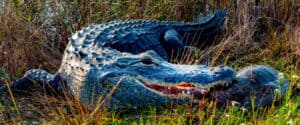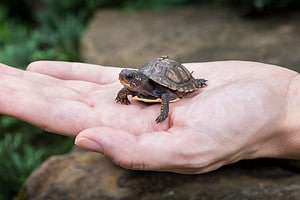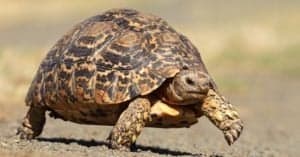Although it’s the world’s smallest continent by landmass, Australia is the sixth largest country on the planet! This incredibly biodiverse region is home to more than 40 unique turtle species, from the bizarre side-necked turtles occupying its rivers to the massive sea turtles swimming along its shores. Below, we’ll cover 15 of the most amazing turtles in Australia you should know about, whether you live there, plan on visiting, or are simply curious about its magnificent shelled reptiles!
1. Red-Eared Slider (Trachemys scripta elegans)
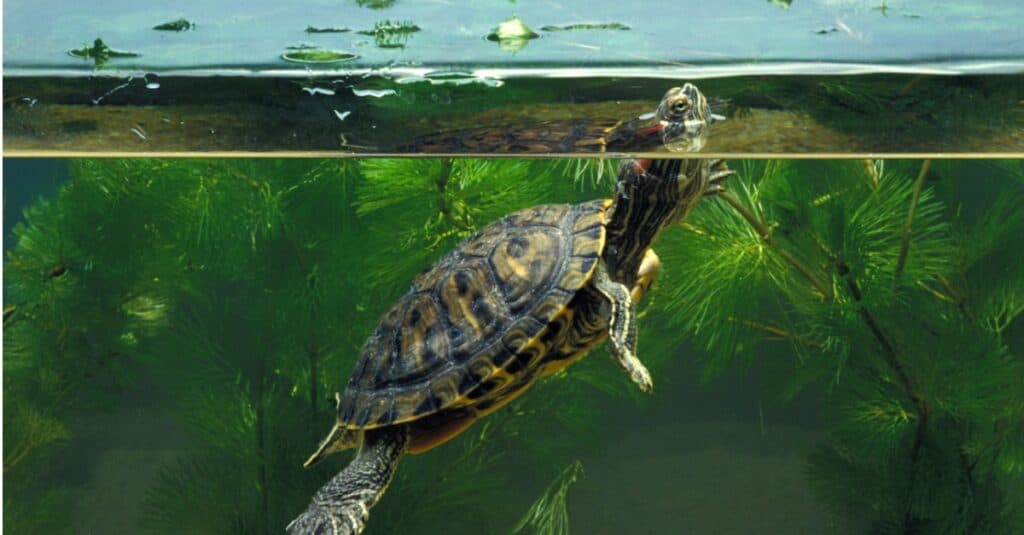
Though it’s actually native to the southeastern US, the Red-Eared Slider now lives throughout much of southern Australia and New South Wales.
©iStock.com/slowmotiongli
As one of the world’s most widespread and invasive turtle species, the red-eared slider has managed to make its way to ‘Straya! Though it’s actually native to the southeastern US, it now lives throughout much of southern Australia and New South Wales, too.
Despite its small size at just 6 to 10 inches on average, this little pond turtle is incredibly hardy. It can thrive in various freshwater habitats, from ponds and lakes to rivers and streams. It’s easy to identify, too, as two large red splotches accent its green and yellow striped skin just behind its eyes.
2. Murray River Turtle (Emydura macquarii)
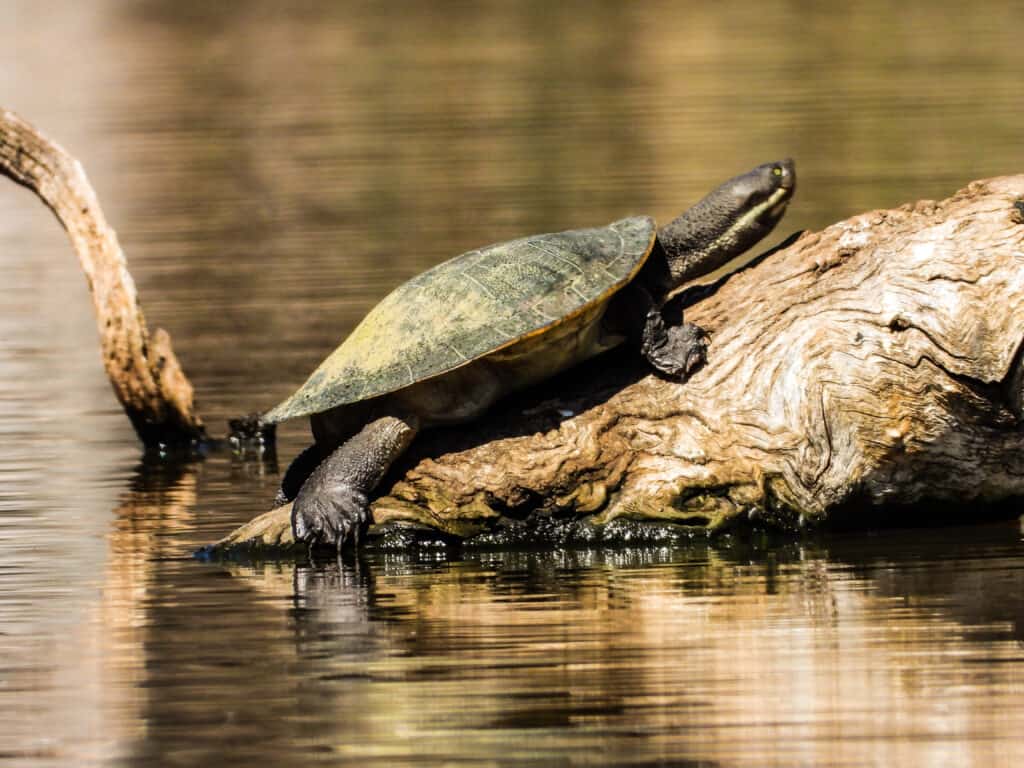
The Murray
River turtle
is one of six species in the
Emyduragenus, collectively known as Australian short-necked turtles.
©iStock.com/barmah john
The Murray River turtle has many common names, including the eastern short-necked turtle and the Macquarie River turtle, among others. It lives throughout eastern Australia’s rivers and streams, most commonly found along the Macquarie River.
On average, the Murray River turtle is around 10 to 12 inches long. Its dark grey to greenish-brown carapace is wider at the rear half than the front half, and the rim of the shell flares up and outward slightly. It is one of six species in the Emydura genus, collectively known as Australian short-necked turtles.
3. Broad-Shelled Turtle (Chelodina expanse)
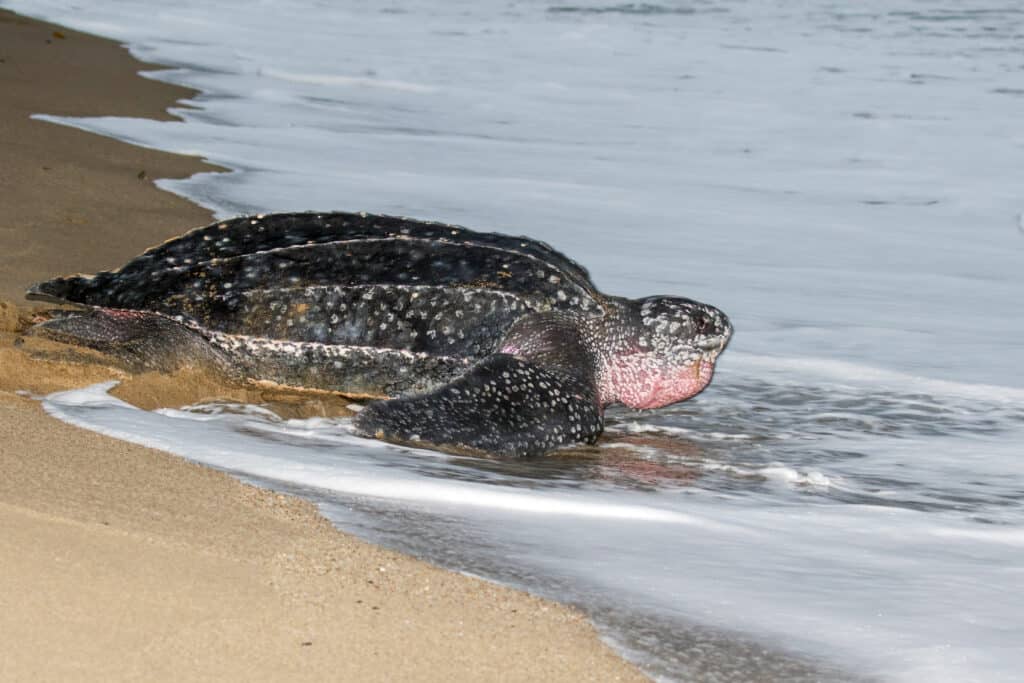
The Leatherback sea turtle (Dermochelys coriacea) has the longest neck of any turtle species in the world.
©iStock.com/AGAMI stock
The broad-shelled turtle is Australia’s largest freshwater turtle species! Incredibly, it also has the longest neck of any turtle species worldwide. In total length, its neck is usually equal to or even longer than its entire shell!
This massive reptile’s shell alone averages 20 inches in length. The underside of its shell, the plastron, is also quite small and narrow. This, combined with its strong, flexible neck, gives the turtle an impressive range of mobility despite its bulky size. It lives throughout southeast Australia, primarily along the Murray-Darling river basin.
4. Eastern Long-Necked Turtle (Chelodina longicollis)

Eastern Long-necked Turtle can spray a foul-smelling odor from its scent glands to repel predators.
©iStock.com/Ken Griffiths
This unique species is a side-necked turtle, meaning it tucks its head and long neck sideways into its shell rather than pulling it straight back like most other turtle species. It averages 7 to 10 inches in carapace length. However, its long neck adds several more inches when fully extended. The outer rim of its shell has alternating black and yellow stripe-like markings.
Like America’s common musk turtle, the eastern long-necked turtle has a smelly defense mechanism! It can spray a foul-smelling odor from its scent glands to repel predators. If you want to observe this turtle in action, you can find it in various freshwater habitats throughout southeast Australia. Just be careful not to get too close!
5. Leatherback Sea Turtle (Dermochelys coriacea)

The leatherback sea turtle is the world’s largest non-crocodilian reptile, often weighing anywhere from 600 to 1,000 pounds or more.
©iStock.com/YasserBadr_Beenthere
Australia is home to six of the seven total sea turtle species. Out of all of them, the leatherback is the largest and one of the most common along its shores. It’s actually the world’s largest non-crocodilian reptile, often weighing anywhere from 600 to 1,000 pounds or more. It’s fairly easy to identify by the seven raised ridges, or keels, stretching lengthwise down its dark grey carapace.
Leatherback sea turtles are most commonly spotted along Australia’s central and southeastern coasts. They don’t typically breed in Australia, though they often feed just off its shores. It has the widest range of any sea turtle species, typically swimming thousands of miles in a single season.
6. Pig-Nosed Turtle (Carettochelys insculpta)
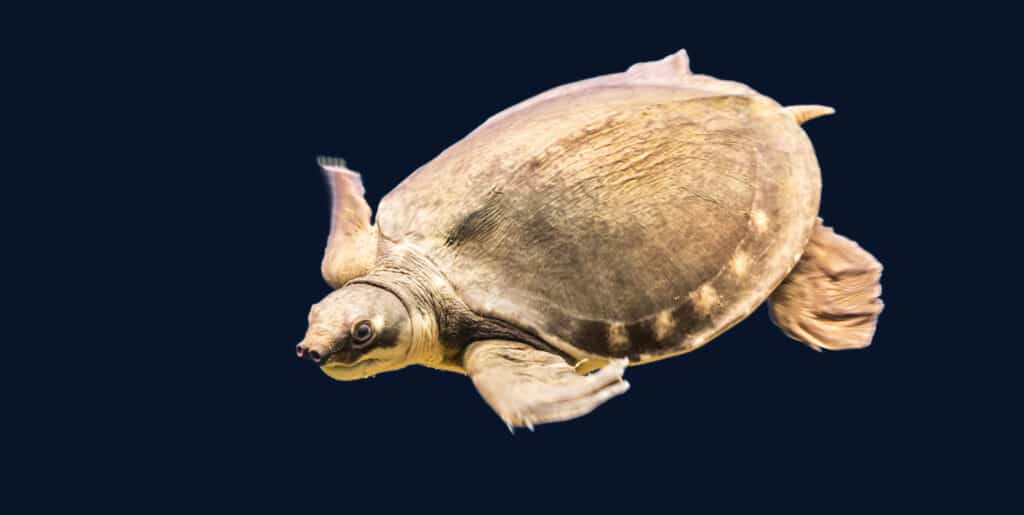
Unlike true softshell turtles, the pig-nosed turtle has a hard, domed carapace instead of a flat, soft plate.
©iStock.com/rep0rter
This bizarre little turtle is the only living member of its genus, Carettochelys. It is fairly closely related to softshell turtles. Unlike true softshell turtles, though, this species has a hard, domed carapace instead of a flat, soft plate. Because this hard dome lies under its skin, though, the surface of its skin still looks and feels leathery and soft.
The pig-nosed turtle is easy to identify, thanks to several key traits. For starters, true to its name, its snout is somewhat elongated and slightly upturned. This makes it resemble the snouts of softshell turtles like the smooth and spiny softshells. It’s also large, averaging 28 to 30 inches long and often weighing over 40 pounds. Finally, the rim of its grey carapace is lined with white splotches.
7. Irwin’s Turtle (Elseya irwini)
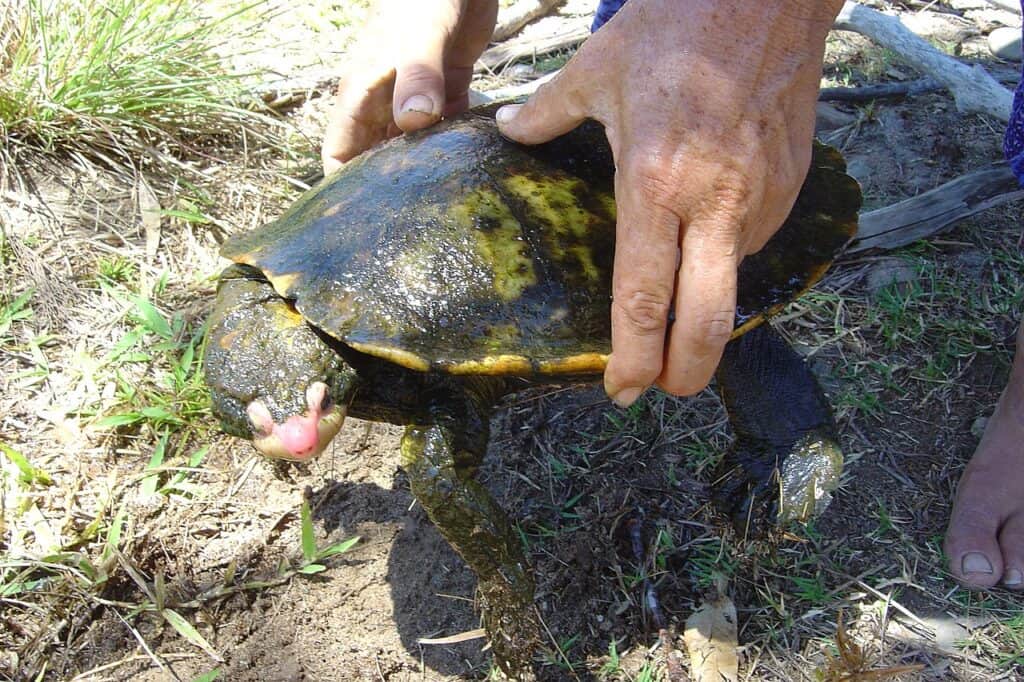
Bizarrely, Irwin’s turtle is mostly greenish-brown in color but has a pale, pinkish-white head.
©Ian Sutton from Oberon, Australia / CC BY 2.0 – Original / License
Named in honor of Steve Irwin, the Irwin’s turtle is a rare species native to northern Queensland. The species was discovered in 1990 by Steve and his father, Bob Irwin while intending to catch and study crocodiles along the Burdekin River.
Bizarrely, Irwin’s turtle is mostly greenish-brown in color but has a pale, pinkish-white head. This unusual coloration is caused by a lack of certain pigments in its skin and shell. It’s also notable for its ability to breathe through its cloaca by using it to exchange respiratory gases while underwater.
8. White-Throated Snapping Turtle (Elseya albagula)
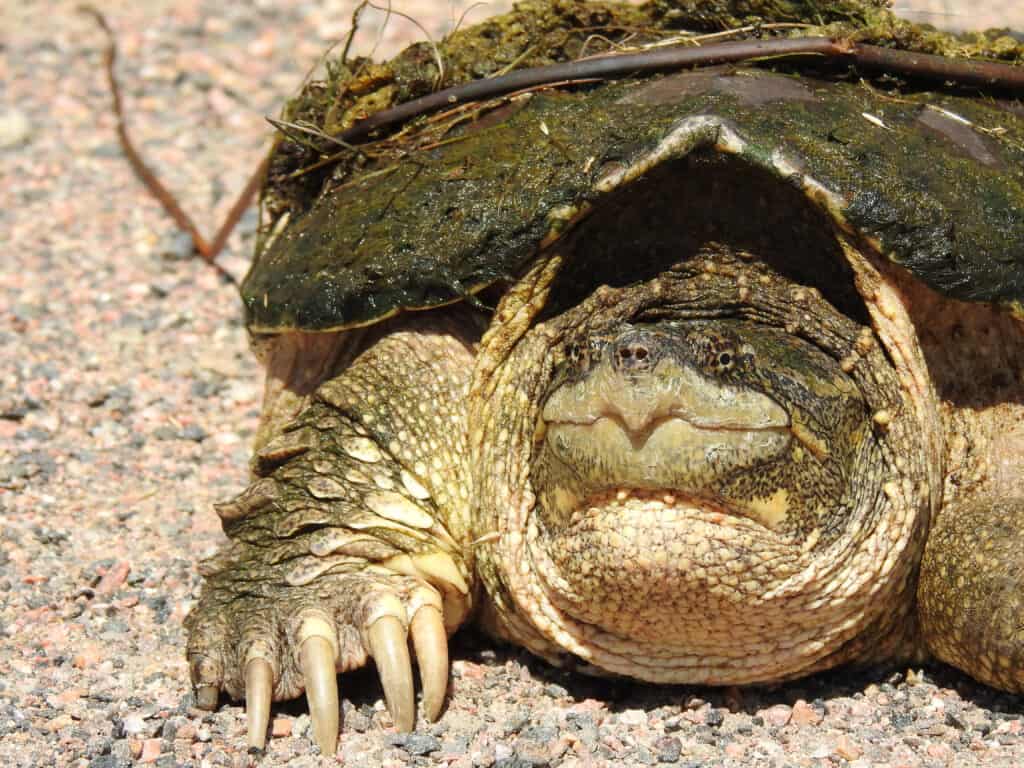
As its name suggests, the white-throated snapping turtle is known for its pale white chin, snout, and throat area.
©iStock.com/Emily Jackson Photography
The white-throated snapping turtle is one of the world’s largest side-necked turtles! Its carapace typically reaches 16 to 18 inches long. It’s native to southeastern Queensland, primarily in and along the Fitzroy, Mary, and Burnett Rivers. As a highly aquatic species, it rarely leaves these rivers.
As its name suggests, this turtle is known for its pale white chin, snout, and throat area, while the rest of its skin is mostly greenish-brown. However, this pale coloration around the throat is only present in females of the species.
Currently, the white-throated snapping turtle is endangered in Australia. This is primarily due to habitat loss from dam construction on the rivers they commonly inhabit.
9. Dinner Plate Turtle (Chelodina steindachneri)
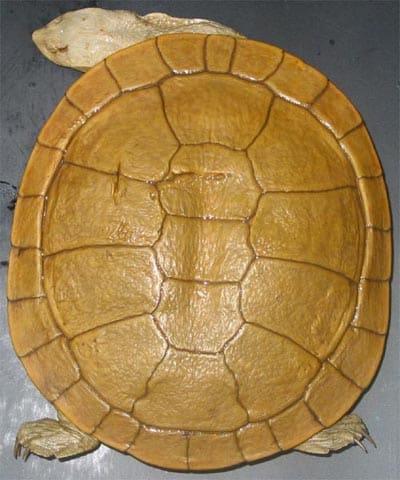
Despite its large shell size, the dinner plate turtle is one of the smallest long-necked turtles in the Chelodina genus.
Also known as the Steindachner’s Turtle, this unique species has a very large, round shell. Its light to dark brown carapace is so perfectly round and flat that it looks just like a dinner plate! Interestingly, despite its large shell size, it’s one of the smallest long-necked turtles in the Chelodina genus.
While its shell is just 8 to 10 inches long, this turtle’s long neck adds several more inches to its total body length when fully extended. It mainly lives in Western Australia and prefers freshwater habitats like rivers, ponds, lakes, and swamps. It resembles and is closely related to the eastern long-necked turtle.
10. Bellinger River Turtle (Myuchelys georgesi)
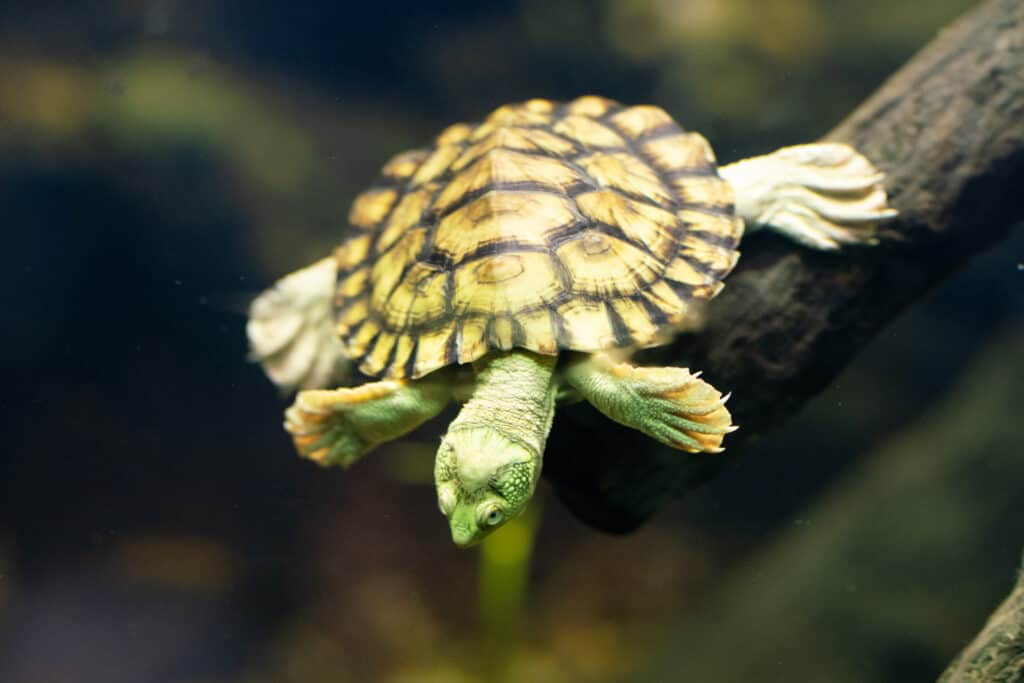
The Bellinger River snapping turtle is critically endangered due to its very limited habitat range and a virus that eliminated 90% of its numbers in 2015.
©iStock.com/Julien Viry
The Bellinger River turtle is one of Australia’s rarest turtles. Currently, it is critically endangered due to its very limited habitat range and a virus that eliminated 90% of its numbers in 2015. Thankfully, captive breeding efforts have been made to restore the species to its former glory.
As its name implies, this species primarily resides along New South Wales’ Bellinger River. Its carapace averages 6 to 10 inches long. Its skin is greyish-brown with yellow stripes along its chin and throat. Despite its small size, it has a rather large head and large, webbed feet.
11. Gulf Snapping Turtle (Elseya lavarackorum)

Unfortunately, the Gulf Snapping Turtle is currently endangered due to habitat loss.
Also known as the Lavarack’s turtle, this large species is mainly native to northern Australia and Queensland. Its scientific name is in honor of Australian paleontologists Jim and Sue Lavarack, who first discovered its fossilized remains in 1994. Unfortunately, it is currently endangered due to habitat loss.
This fairly large turtle has an average carapace length of around 12 to 14 inches. Its carapace is usually greyish brown and is quite flat. As a highly aquatic species, it rarely leaves the water, except to occasionally bask in the sun and lay its eggs.
12. Flatback Sea Turtle (Natator depressus)
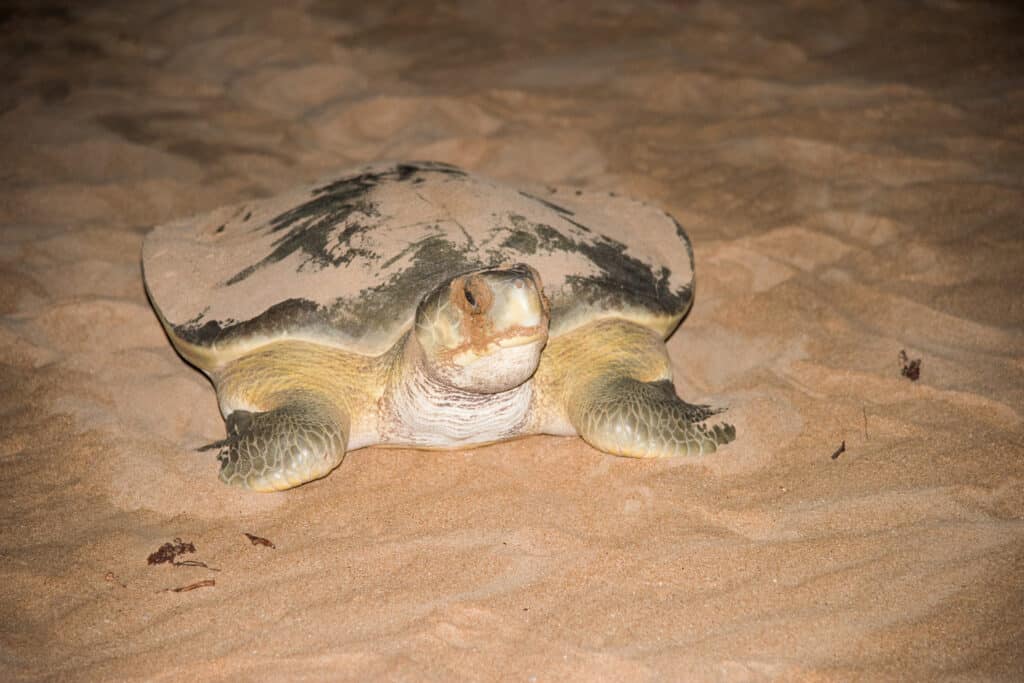
True to its name, the flatback sea turtle has a flattened carapace.
©iStock.com/EAGiven
This unique sea turtle is native to Australia’s coasts. Because it is limited to this area, it has the smallest geographic range of all seven sea turtle species. It prefers shallow waters and doesn’t travel or migrate very long distances.
True to its name, the flatback sea turtle has a flattened carapace. The outer rim of the shell, however, flares slightly out and upwards. Its shell and skin vary in color from grey to greenish-brown. Notably, it’s also one of the smallest sea turtle species. On average, it measures 30 to 38 inches in carapace length and weighs 150 to 200 pounds.
13. Western Swamp Turtle (Pseudemydura umbrina)
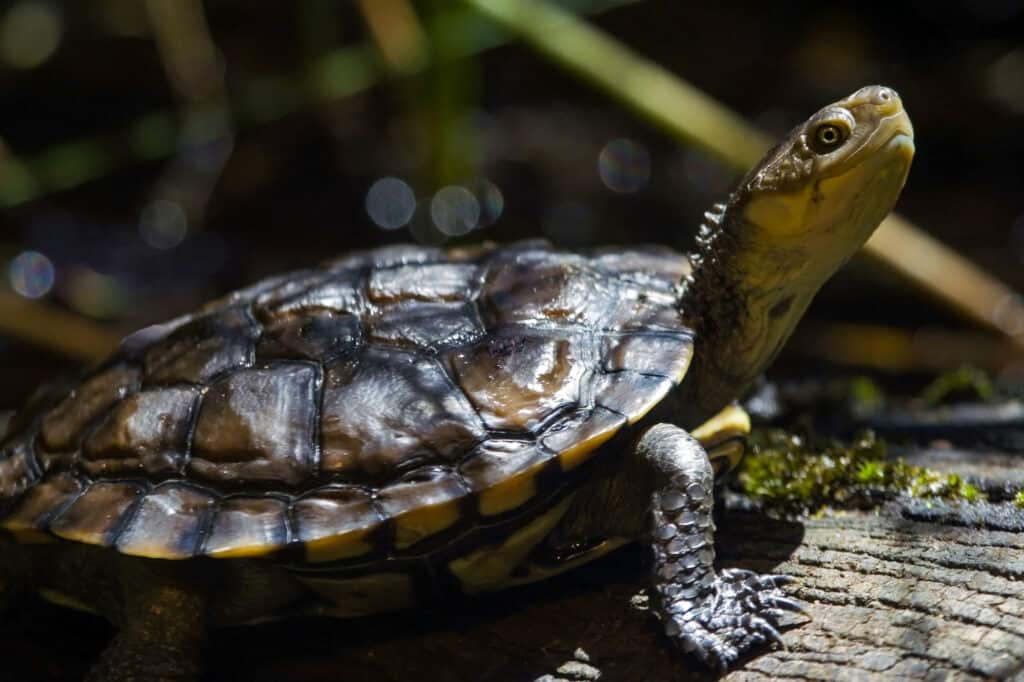
The western swamp turtle is the smallest side-necked turtle in Australia.
©john austin/Shutterstock.com
This critically endangered species has a very limited geographic range. It can mainly be found in Western Australia along the Swan Coastal Plain. Its habitat has changed significantly due to construction and climate change, and as a result, only small, scattered populations remain.
The western swamp turtle is the smallest side-necked turtle in Australia. Generally, males average just 5 to 6 inches long, and females are slightly smaller. Its color varies depending on age and habitat, ranging from grey to yellowish-brown and even dark brown. Interestingly, it’s the only member of its genus, Pseudemydura.
14. Northern Snake-Necked Turtle (Chelodina rugosa)

The northern snake-necked turtle’s carapace averages 8 to 10 inches long.
©iStock.com/Florian DENIS
Also known as the northern long-necked turtle, this species mainly resides in northern Australia and southern New Guinea. Although it prefers freshwater habitats, it can also tolerate brackish water.
The northern snake-necked turtle’s carapace averages 8 to 10 inches long. However, like most long-necked turtles, its massive neck can be half as long as its shell and adds several inches to its total body length when fully extended. Its dark brown, oval-shaped carapace is also slightly wider in the rear half than the front half. Meanwhile, its skin is usually dark grey with a pale yellowish underside.
15. Saw-Shelled Turtle (Myuchelys latisternum)
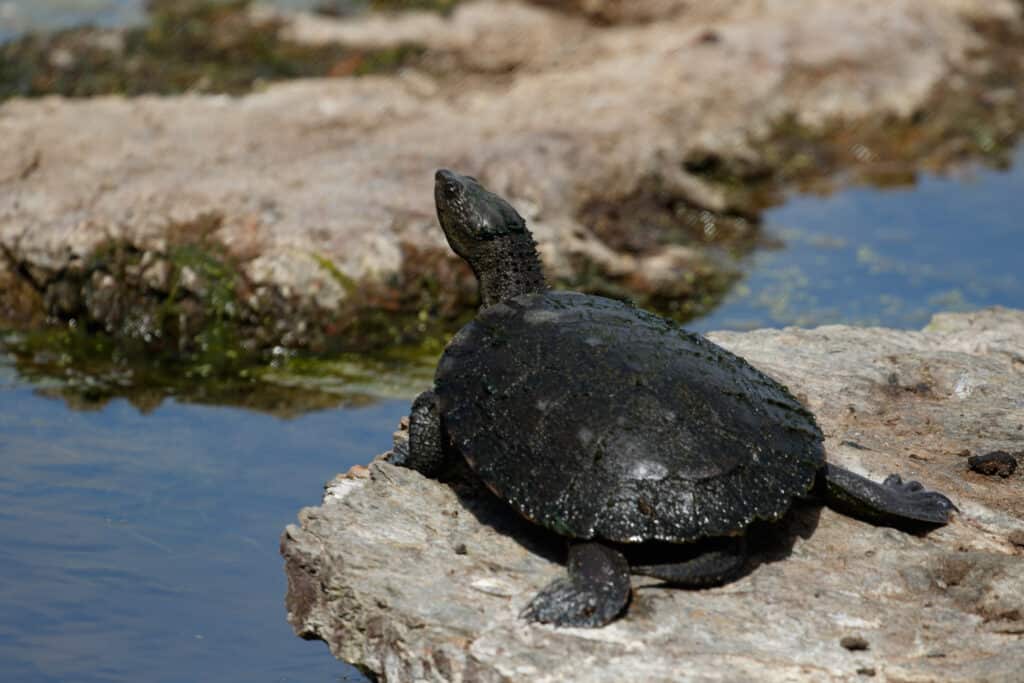
Saw-Shelled Turtle (Myuchelys latisternum) has a uniquely serrated look to the edges of its carapace.
©iStock.com/Joshua Prieto
We’ll cap off this list of Australia’s most amazing turtles with the saw-shelled turtle. True to its common name, this species has a uniquely serrated look to the edges of its carapace. It averages 7 to 10 inches in carapace length, with females being much longer and larger than males.
The saw-shelled turtle’s geographic range is mainly limited to northern Australia and Queensland. However, small populations also exist in northern New South Wales. The species can thrive in various freshwater habitats, including rivers, lakes, and swamps. Like those mentioned above, the eastern long-necked turtle can also spray a foul-smelling odor from its scent glands.
Up Next:
The photo featured at the top of this post is © iStock.com/Julien Viry
Thank you for reading! Have some feedback for us? Contact the AZ Animals editorial team.




